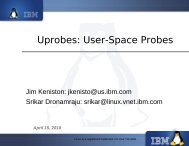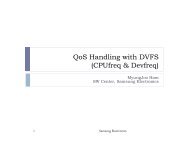Extending the swsusp Hibernation Framework to ARM - The Linux ...
Extending the swsusp Hibernation Framework to ARM - The Linux ...
Extending the swsusp Hibernation Framework to ARM - The Linux ...
- No tags were found...
Create successful ePaper yourself
Turn your PDF publications into a flip-book with our unique Google optimized e-Paper software.
Motivation• <strong>Hibernation</strong> provides zero power consumption sleep• Allows for snapshot boot• Shares requirements with self-refresh only sleep modes– RTC-Only+DDR self-refresh
<strong>swsusp</strong>• Mainline hibernation implementation since 2.6.0– TuxOnIce (Suspend2)• Uses swap device <strong>to</strong> s<strong>to</strong>re image• Can be used with u<strong>swsusp</strong> <strong>to</strong> support additional features– Encryption– Limitless s<strong>to</strong>rage options– Graphical progress• Limited <strong>to</strong> snapshotting 1/2 of system RAM
<strong>swsusp</strong>
<strong>swsusp</strong>
OMAP PM• Clocks– Clock gating• Power– Clock domains– Clock scaling– Power domains●●LogicRetention– Voltage scaling• PRCM Controls <strong>the</strong>se features
AM33xx PM Overview• MPU, PER, and GFX power domainscan be turned off during suspend• Current OMAP PM core assumesWKUP domain will always havepower
WKUP Context• Used for:– Power, reset, and clock management (PRCM)– Pin mux configuration– modules that wake up <strong>the</strong> processor from suspend• After hibernation, we need <strong>to</strong> res<strong>to</strong>re this state
PRCM• Power domains– Represented by arch/arm/mach-omap2/powerdomain.c
PRCM• Reset state and module state– Represented by omap_hwmod, leverage it
PRCM• Clocks domains– Represented by arch/arm/mach-omap2/clockdomain.c
PRCM• Clocks– Leverage <strong>the</strong> clock tree by adding context save/res<strong>to</strong>re callbacks
pinctrl• Controls how internal signals are routed <strong>to</strong> external pins• Contains memory map of register area, but no complete description ofregisters• AM335X errata complicates <strong>the</strong> situation, certain registers lose contextwhen <strong>the</strong> PER domain powers during suspend• <strong>The</strong> pinctrl subsystem needs knowledge of which registers areavailable, and which domain <strong>the</strong>y are in.
pinctrl• Temporary measure, list each power domain register set as a pinconffunction
pinctrl• Code added <strong>to</strong> pinctrl <strong>to</strong> save/res<strong>to</strong>re a pinctrl function group
pinctrl• Current solution is a bit of a hack and likely not upstreamable.• Possible solution?– New type of pinctrl register grouping– Would contain reference <strong>to</strong> power domain register group iscontained in– Code could use syscore suspend/resume callbacks <strong>to</strong> save andres<strong>to</strong>re context• Problem– omap2+ power domains are currently arch specific
clocksource/clockevent• Clockevent is already handled properly, disabling on suspend andreprogramming on resume• Clocksource is assumed <strong>to</strong> be always running and within a domain thatdoes not lose power• Clocksource is also required for many kernel delay calculations. Mustbe res<strong>to</strong>red before most o<strong>the</strong>r kernel code
SRAM• Internal memory on many OMAP processors used <strong>to</strong> run suspendresume code or code that modifies memory controller registers orclocking• Currently res<strong>to</strong>red for OMAP3, but in an OMAP3 specific way – Make itmore general instead
O<strong>the</strong>r Devices• Many devices just need <strong>to</strong> know that <strong>the</strong>ir power domain lost context• Teach arch/arm/mach-omap2/powerdomain.c about hibernationinduced off modes.
O<strong>the</strong>r Devices• Many devices that depend on a context loss count function pointer donot get that pointer under DT based systems– gpio-omap– omap_hsmmc– omap-serial• Currently a hack fix with a pointer <strong>to</strong>omap_pm_get_dev_context_loss_count• <strong>The</strong>re is a need for a generic framework <strong>to</strong> inform devices when <strong>the</strong>yhave lost power
O<strong>the</strong>r Devices●●●Some devices misconfigured in such a way <strong>to</strong> preventsuspend/resume callbacks duringhibernationWhen not using dev_pm_ops, <strong>the</strong>platform_driver .suspend/.resumecallbacks are used for hibernationthaw/freeze/res<strong>to</strong>re/powerofffunctionalityHowever, when using dev_pm_ops<strong>the</strong>se must be filled in. <strong>The</strong> helpermacro, SET_SYSTEM_SLEEP_PM_OPS should be used <strong>to</strong> fill in <strong>the</strong>thaw/freeze/res<strong>to</strong>re/poweroff callbacks (unless specialthaw/freeze/res<strong>to</strong>re/poweroff behavior is required).
O<strong>the</strong>r Devices• Some device *do* need special hibernation callbacks• <strong>The</strong> omap watchdog requires special handling because <strong>the</strong> state of <strong>the</strong>watchdog under <strong>the</strong> boot kernel is not known
Saving/Res<strong>to</strong>ring WKUP Domain• Putting it all <strong>to</strong>ge<strong>the</strong>r in pm33xx.c
<strong>Hibernation</strong> support for <strong>ARM</strong>• Minimum implementation– <strong>swsusp</strong>_arch_suspend●●●Save current cpu stateCall <strong>swsusp</strong>_save <strong>to</strong> snapshot memoryReturn control <strong>to</strong> <strong>swsusp</strong>_arch_suspend caller– <strong>swsusp</strong>_arch_resume●●●Perform page copies of pages in <strong>the</strong> res<strong>to</strong>re_pbelistRes<strong>to</strong>re cpu state from <strong>swsusp</strong>_arch_suspendReturn control <strong>to</strong> <strong>swsusp</strong>_arch_suspend caller– pfn_is_no_save●Return true if this pfn is not <strong>to</strong> be saved in <strong>the</strong> hibernation image– save_processor_state●Save any extra processor state (fp registers, etc)– res<strong>to</strong>re_processor_state●Res<strong>to</strong>re extra processor state
<strong>Hibernation</strong> support for <strong>ARM</strong>• <strong>swsusp</strong>_arch_suspend– Utilizes cpu_suspend <strong>to</strong> save current cpu state– Second argument of cpu_suspend is called after state is saved– Calling cpu_resumecauses execution <strong>to</strong>return <strong>to</strong> cpu_suspendcaller– Utilizing soft_restartdisables MMU ascpu_resume expects
<strong>Hibernation</strong> support for <strong>ARM</strong>• <strong>swsusp</strong>_arch_resume– Uses stack allocated innosave region <strong>to</strong> preven<strong>to</strong>urselves fromoverwriting our stack– We will overwrite ourcode, but with <strong>the</strong> samebytes– Uses cpu_resume <strong>to</strong>res<strong>to</strong>re cpu state andreturn <strong>to</strong> cpu_suspendcaller
AM33xx <strong>Hibernation</strong> Support• With prep work done, adding hibernation support <strong>to</strong> AM33xx is actuallyfairly straightforward• begin/end wrap all hibernation code• We use disable/enable_hlt <strong>to</strong> preventpm_idle from being called• <strong>The</strong> enter call back just powers down<strong>the</strong> machine• <strong>The</strong>se calls make sure that <strong>the</strong>hardware is in <strong>the</strong> same state beforerunning <strong>the</strong> res<strong>to</strong>red image as when itwas made
AM33xx <strong>Hibernation</strong> Support●●●pre_snapshot saves all our state registers and prepares <strong>the</strong> GPIOsfor power lossleave is called after res<strong>to</strong>ring an image. We inform <strong>the</strong> powerdomains that <strong>the</strong>y have lost power and we res<strong>to</strong>re our wkup contextfinish is called both afterres<strong>to</strong>ring an image (after leave)and after snapshotting <strong>the</strong>system. We continue ourcontext res<strong>to</strong>re and also undo<strong>the</strong> actions in pre_snapshot
Debugging Methods• Debugging can be difficult as <strong>the</strong> hardware is usually in some unknownstate.• Debugging using GPIOs– GPIOs are usually pretty easy <strong>to</strong> configure clocks for and enablewith just a few register writes, even from assembly• printk– Binary search of where <strong>the</strong> code is failing can be performed bymoving <strong>the</strong> GPIO enable around– <strong>The</strong> kernel logging facility is useful so long as you are getting <strong>to</strong> apoint where serial output is enabled• Register map comparisons– Utilizing devmem2 <strong>to</strong> snapshot register values before and after ahibernation file is useful <strong>to</strong> track down missed registers or buggyres<strong>to</strong>re code
Res<strong>to</strong>re from U-Boot31
<strong>swsusp</strong> and U-Boot• Res<strong>to</strong>ring from hibernation just involves copying pages from disk in<strong>to</strong>memory and jumping <strong>to</strong> an address– Thats what U-Boot does!• Res<strong>to</strong>ring from U-Boot can be faster than booting a kernel just <strong>to</strong> copypages• Issues– U-Boot has no idea what address<strong>to</strong> jump <strong>to</strong>– U-Boot doesn’t know <strong>the</strong>contents or even locationof <strong>the</strong> nosave pages
Kernel Modifications• U-Boot doesn’t know aboutnosave pages or <strong>the</strong>ir address• We instead save and res<strong>to</strong>re<strong>the</strong>m from <strong>the</strong> kernel• Backup nosave pages aresaved at boot• Special version of cpu_resumeis provided that res<strong>to</strong>resnosave pages before calling<strong>the</strong> real cpu_resume
Kernel Modifications• Need <strong>to</strong> pass address of cpu_resume function <strong>to</strong> U-Boot– S<strong>to</strong>re in <strong>swsusp</strong>_info page– Add arch callback for s<strong>to</strong>ring that data in <strong>the</strong> <strong>swsusp</strong>_page• Just s<strong>to</strong>res <strong>the</strong> physical address of <strong>the</strong> new version of cpu_resume thatfirst copies <strong>the</strong> nosave pages
<strong>swsusp</strong> Image Layout●●Each metadata entry is associated with <strong>the</strong> same numbered datapageEach data page is <strong>to</strong> be loaded in<strong>to</strong> memory at <strong>the</strong> pfn indicated byits metadata pfnentry
U-Boot modifications• Provide cmd_<strong>swsusp</strong>– No-op if S1SUSPEND sigdoes not exist– Rewrites sig with orig_sig <strong>to</strong> prevent boot loop on bad image●Snapshot booting can populate orig_sig with S1SUSPEND– Reads in metadata pages with pfn mappings●Also populates bitmap of used pages for easy access <strong>to</strong> free pages– Copy each data page <strong>to</strong> memory●●Original location if it is freeO<strong>the</strong>r wise copy <strong>to</strong> first available free page and update remap list– Copy finish function and cpu_resume address <strong>to</strong> free data page– Run finish function from free data page (use stack contained in free page)●●Copies remapped pages <strong>to</strong> <strong>the</strong>ir correct locationJumps <strong>to</strong> cpu_resume function
U-Boot Memory Mapping• <strong>The</strong> U-Boot memory mapping makes it very easy <strong>to</strong> see ifwe can load a page directly in<strong>to</strong> its original location• If not, we load it in<strong>to</strong> a location not used by U-Boot or <strong>the</strong>final location of any of <strong>the</strong> <strong>swsusp</strong> pages
Loading pfn and Free Page Mapping• We utilize malloc’d pages <strong>to</strong> s<strong>to</strong>re <strong>the</strong> pfn index• Mark used pages as we go
Loading <strong>swsusp</strong> Pages In<strong>to</strong> Memory• Utilize free pages <strong>to</strong> s<strong>to</strong>re remapping lists, malloc’d data will beoverwritten• min_page is first free page in U-Boot memory map• max_page is last free page in U-Boot memory map (well before stackpointer)• If a page is <strong>to</strong> be copied in<strong>to</strong>U-Boot’s memory space, it isinstead copied in<strong>to</strong> an unusedfree page
Prepare <strong>to</strong> Copy Remapped Pages• Final copy must happen from memory unused by <strong>swsusp</strong> or U-Boot– remap_orig/remap_temp already exist in free page– Utilize free page for final copy of remapped pages●●●Copy <strong>swsusp</strong>_finish in<strong>to</strong> pageCopy contextinformation in<strong>to</strong> pageSetup stack pointer atend of page
Copy Remaining Pages• Moved remapped pages in<strong>to</strong> <strong>the</strong>ir originally intended location• Call cpu_resume (actually cpu_resume_copy_nosave)
Questions?
Introducing:<strong>The</strong> Next-Gen BeagleBoneAn introduction worthy of a black tie affair.• New color for Spring• New and improved features• Bold move <strong>to</strong> more performancefor lower costWant a sneak peek and information onadvanced ordering options?Make an impression. Register your interest <strong>to</strong>day.beagleboard.org/unzipped
















